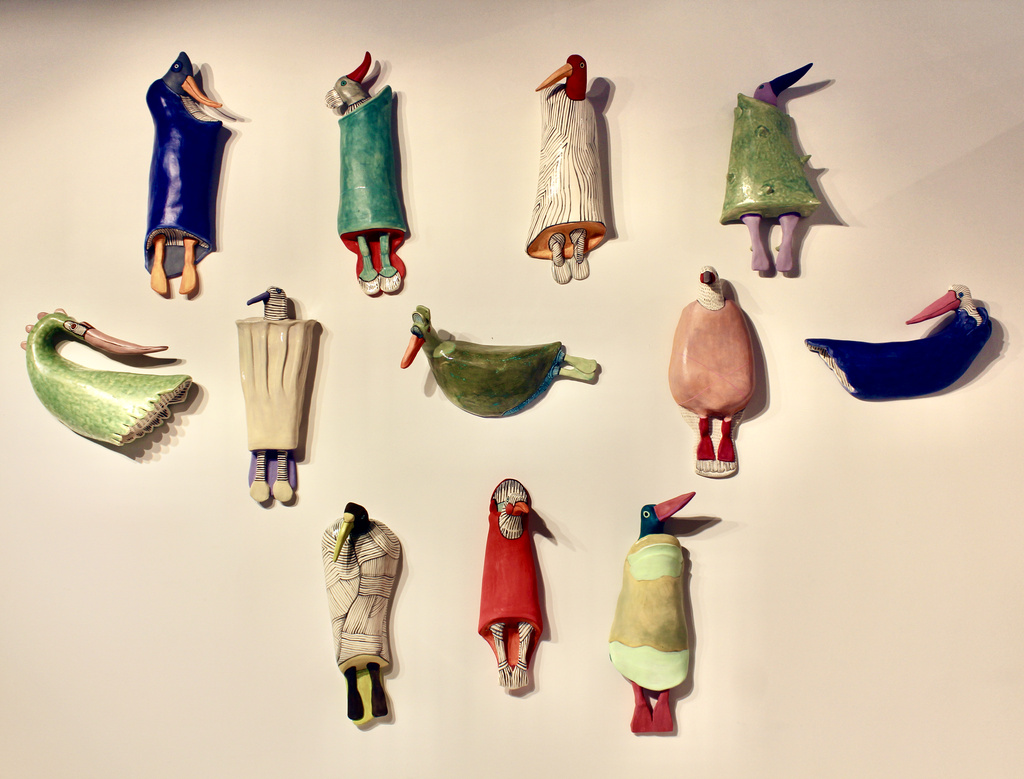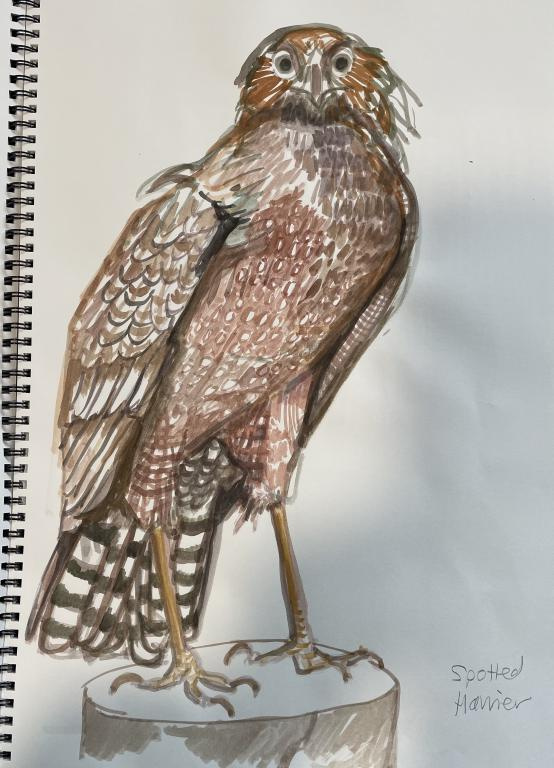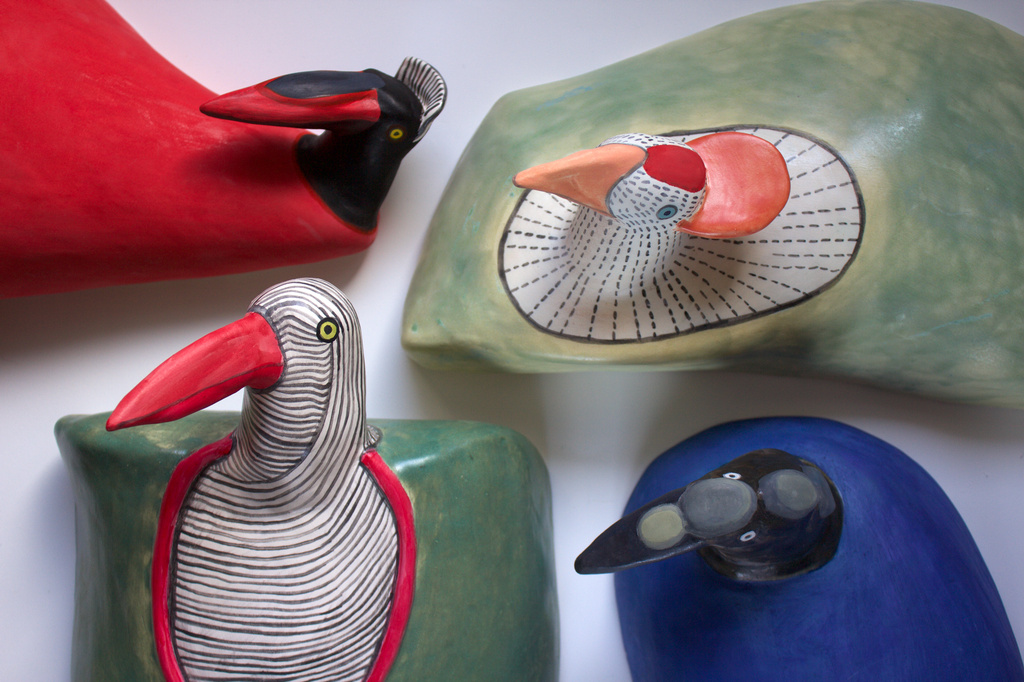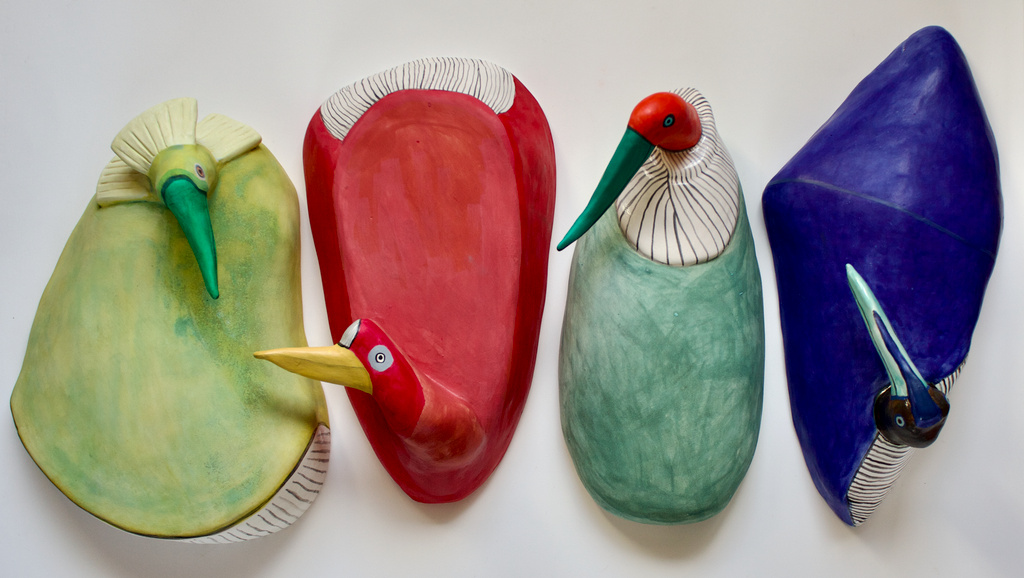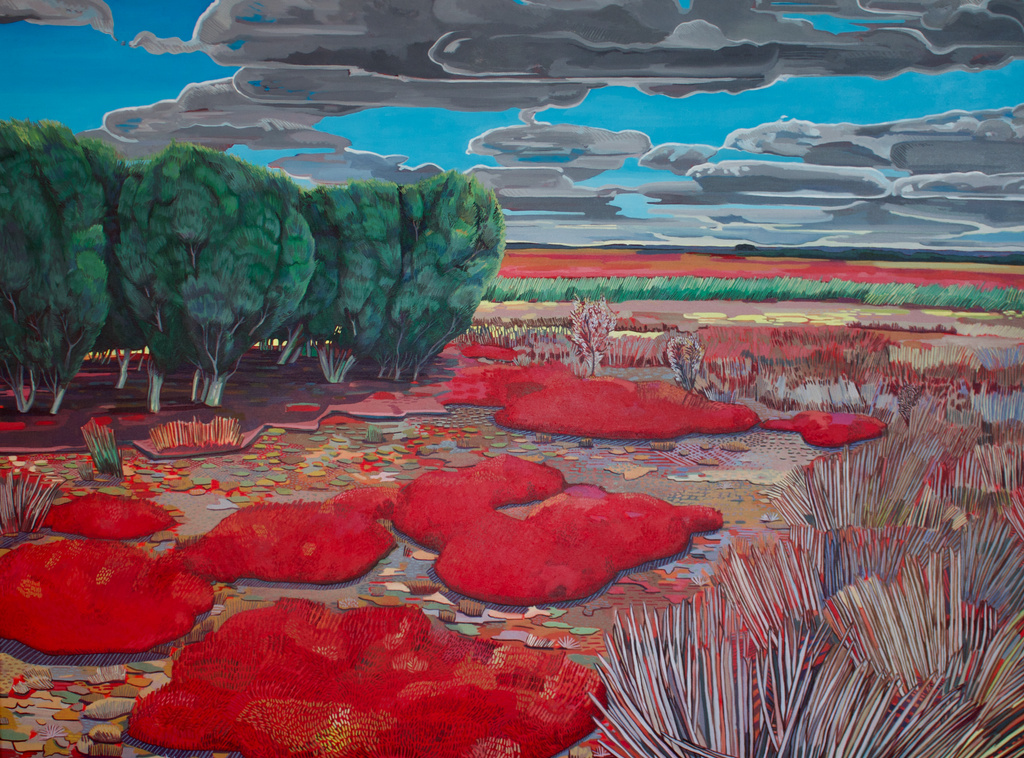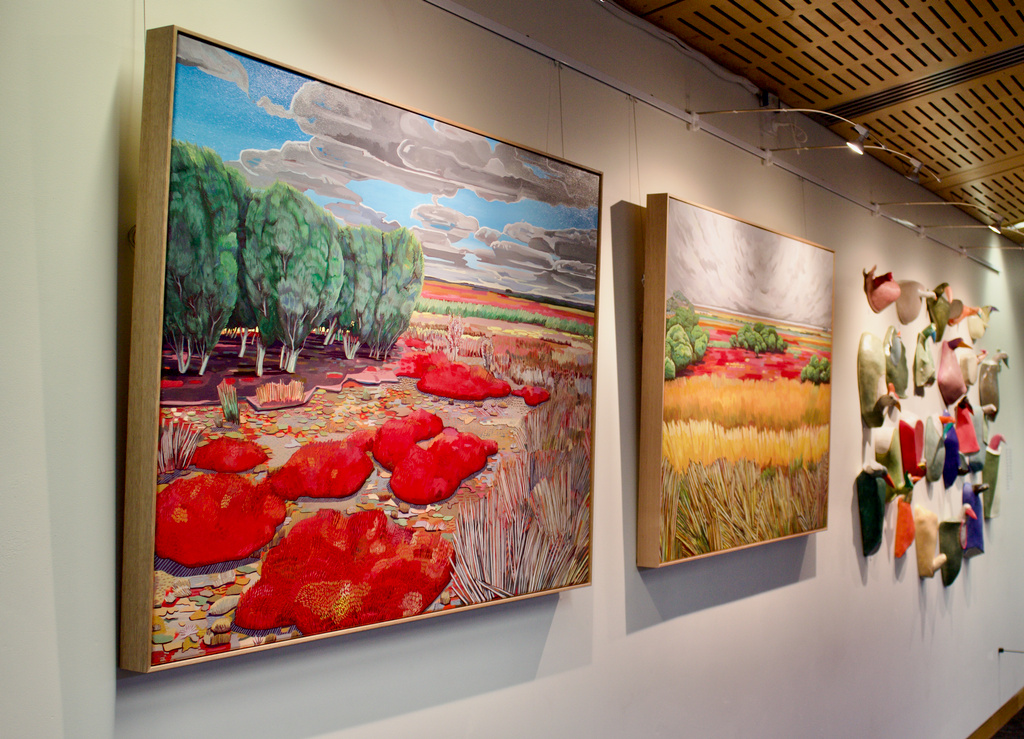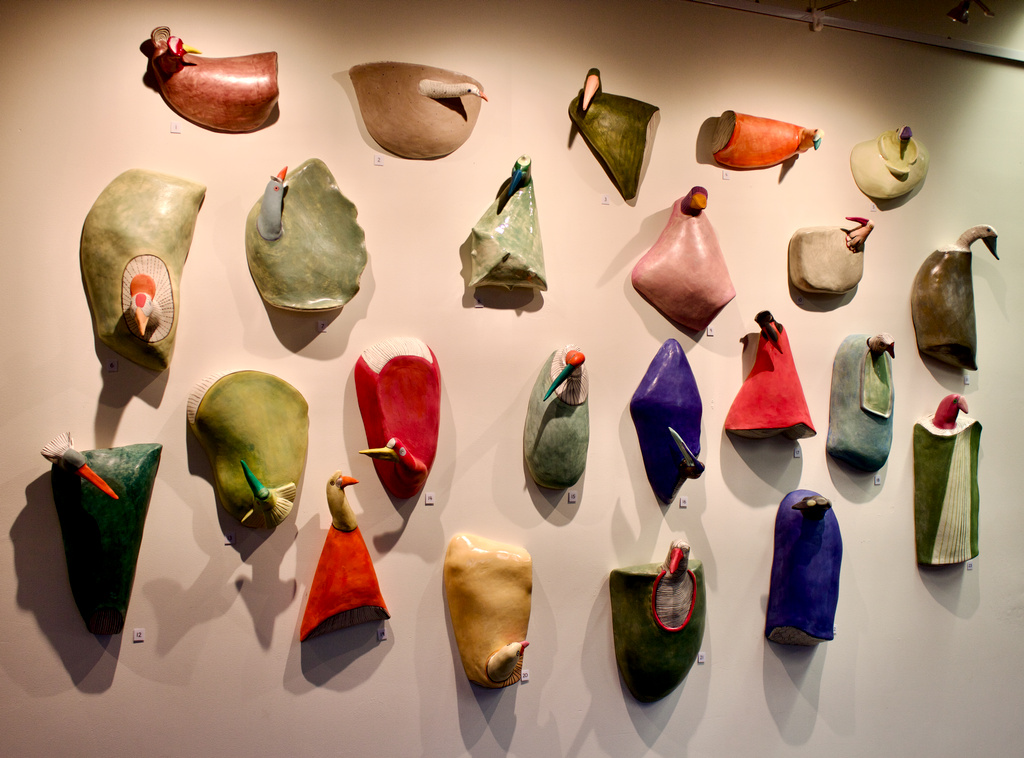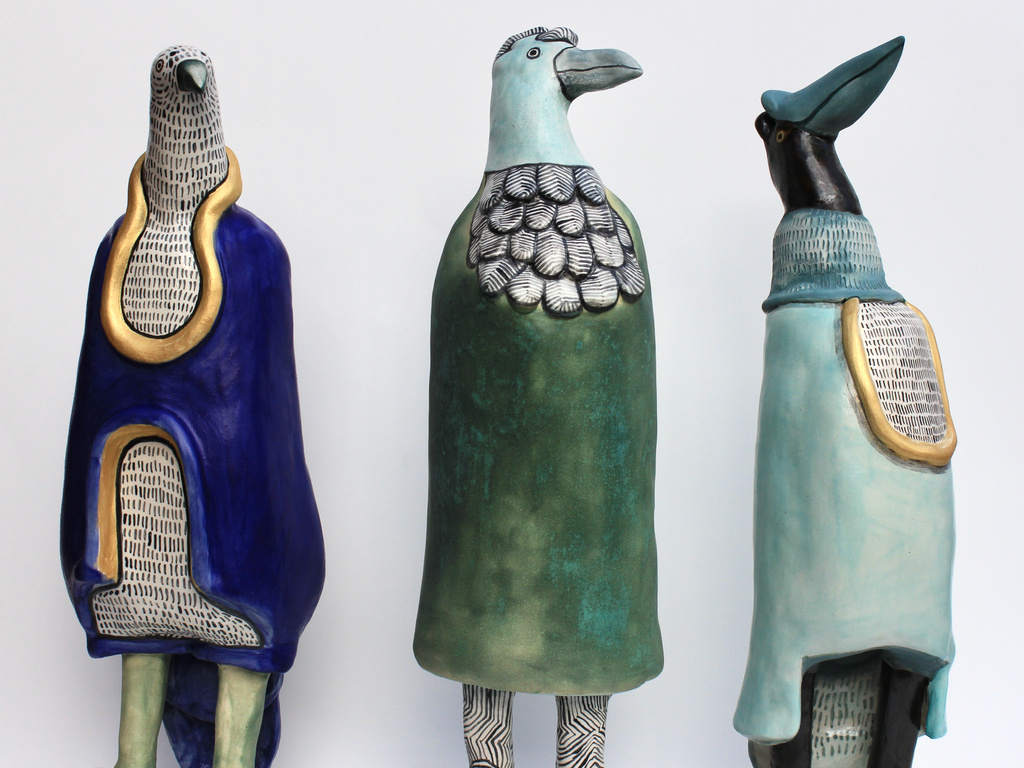
Thea Katauskas, Royal Shelf Pigeon, Tilted Message Hawk and Tipping Tide Monitor from the Adaptor Birds series, 2023. Earthenware, glazes, ink, enamel paint and timber. Dimensions varied – Approximately 46 x 14 x 12 cm each. Photo: Thea Katauskas
Thea Katauskas fashions ceramic birds in response to the threatened diversity she witnessed on the Limestone Coast.
The first Brolgas I ever saw were in a sheep paddock at the edge of Bool Lagoon, South Australia, on a winter morning. Farmers Marion and Craig Patterson, who were hosting me, had glimpsed the recent arrivals the day before and announced that they were back. We walked into the fog across damp grass to pause at a distance and watch the stately pair.
Every year they return, but not in the same numbers that had been visiting and breeding here decades before.
I was invited to stay on this farm as part of an inaugural Artist Residency in Naracoorte, S.A., established by local artist and organiser Diana Perkins. The two-week stay involved being hosted by the Naracoorte Caves National Park, receiving a tour of the Bool and Hacks Lagoon wetlands by local ecologist Abigail Goodman, and having access to Bourne’s Bird Museum — Australia’s only private collection of its kind with over 600 preserved specimens.
It reminds us of the ecosystem’s potential and the changes appearing in backyards there and across the country.
Marion Patterson is now the owner of her father’s taxidermied bird collection from the Limestone Coast region. It provides a rich record of the historic biodiversity of this region and the migratory life in and around Ramsar* protected wetlands of Bool and Hacks Lagoon. As our climate patterns shift and the water tables of the Limestone Coast dry up, this inventory of spectacular bird life is of increasing importance. It reminds us of the ecosystem’s potential and the changes appearing in backyards there and across the country.
Over the last six years, I have been sculpting ceramic forms that are inspired by birds, a recurrent motif I use to process thoughts about our fragile natural environments and the effects of climate change. The initial idea emerged when I joined a community ceramics group in Maryland, USA, and heard of the recent and rapid decline of North American avifauna. Being in a foreign environment allowed me to consider the extraordinary variety of birdlife we live amongst in Australia, and to appreciate them as indicators of environmental balance. My first exhibition of 46 ceramic bird sculptures, ‘Flock’ was shown in Canberra in 2020, and following series of sculptures have explored different aspects of bird life – including ‘Communicators of the Bird World’ (2022), ‘Adaptor Birds’ (2023) and ‘Birdspotting’ (2024) – all creations of imaginary species that reflect the intelligence and beauty of documented species on our planet.
For this reason, visiting the renowned migratory bird habitats of Bool and Hacks Lagoon, and having access to view specimens in Bourne’s Bird Museum, was a generous opportunity for me to take inspiration from this specific environment.
As part of the residency’s goal was to initiate a creative project to bring to the region, my time spent researching and observing the environment during this period was the first step in developing a body of work for exhibition. I took many photographs of the remarkable big sky landscape and Bool Lagoon vegetation, as well as sketched from the bird specimens to note details of body and beak shape, plumage and posture of these beautiful creatures.
- Thea Katauskas, Birdspotting, 2024 at Grainger Gallery, Canberra, installation of ceramic wallbirds, earthenware, glazes, ink and enamel paint, dimensions varied. Photo: Thea Katauskas
- Thea Katauskas, Sketch of a Spotted Harrier, 2025. Watercolour on paper. Photo: Thea Katauskas
- Thea Katauskas, Absent Friends installation (detail). Earthenware, glazes, ink and enamel paint, dimensions varied. Photo: Thea Katauskas
- Thea Katauskas, 4 Birds from Absent Friends installation (detail). Earthenware, glazes, ink and enamel paint, 23 wall mounted sculptures, dimensions varied. Photo: Thea Katauskas
- Thea Katauskas, Bool Lagoon – Samphire Islands, 2025. Oil on canvas, 122 x 91 cm. Photo: Thea Katauskas
- Thea Katauskas, Birdland paintings and ceramics at Walkway Gallery, 2025. Photo: Thea Katauskas
- Thea Katauskas, Absent Friends, 2025. 23 ceramic wallbirds, dimensions varied, earthenware, glazes and enamel paint. Photo: Thea Katauskas
I am now returning to the Limestone Coast region to hang an exhibition, Birdland – Works from a Naracoorte Artist Residency, at Walkway Gallery in Bordertown. The collection of works is a rumination on the landscapes seen in July 2024 (in the form of oil paintings) and an installation of 23 wall-mounted ceramic bird sculptures reflecting a feeling of longing and connection that people of the region have expressed for the birds of Bool Lagoon.
…occasional cloud cover hovered above. A suggestion of rain, which never delivered.
The lagoons were in a winter state during the residency. They were waterless due to seasonal changes and ongoing drought, appearing as grass and reed-fringed expanses, coloured by red and yellow patches of samphire, and punctuated by outcrops of tea tree shrub. Beautiful dry expanses beneath huge blue winter skies with occasional cloud cover hovered above. A suggestion of rain, which never delivered.
Hearing stories of the historic abundance of birdlife, breeding flocks of hundreds of species, and the predictable October cacophony of a yearly mass migration to a thriving wetland ecosystem, left a feeling of joy and appreciation of this natural environment, and a sense of creeping grief at the diminishing presence of these diverse visiting and endemic species.
My artworks have been made with all these thoughts in mind: that nature is spectacular and ever inspiring; us imperfect humans grasp at attempting to capture and record its beauty; that the loss of species in habitats around our world is change happening at a speed which our minds struggle to comprehend; and, that the process of making is a way to initiate joy, playfulness and curiosity.
With a variety of body shapes, beak forms, gestures of movement and glaze colouring, this collection of bird sculptures imagines an arrival of wetland birds to the lagoons, unique characters floating on water.
My creative process starts with a spontaneous assembly of slab clay into organic volumes that suggest a body form, which are then completed by adding a unique combination of neck and beak components. Once fired, the glazing and decoration offer an opportunity to play with colour and pattern in an experimental act of defining a character. These imaginary creatures are an homage to the infinite beauty of the natural world. My upcoming installation, Absent Friends, will refer to unknown or undiscovered species we have yet to encounter.
Notes
* Ramsar wetlands are those that are representative, rare or unique wetlands, or are essential for conserving biological diversity. These are included on the List of Wetlands of International Importance developed under the Ramsar Convention.
No AI was involved in the observing of landscape, thinking or creating of these artworks.
Further Reading
Rosenberg, K.V. et al. (2019). Decline of the North American avifauna. Science, [online] 366(6461), pp.120–124. doi: https://doi.org/10.1126/science.aaw1313.
Mitchell, Brook (2025). That sinking feeling: Australia’s Limestone Coast is drying up. [online] Guardian.
Half as many waterbirds counted in annual survey – BirdLife Australia
About Thea Katauskas
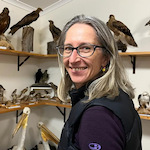 Thea Katauskas is an artist and educator who lives and works on Ngunnawal country. She works mainly as a sculptor, painter and printmaker and takes inspiration from the natural world. Visit www.theakatauskas.com and follow @katauskas.thea
Thea Katauskas is an artist and educator who lives and works on Ngunnawal country. She works mainly as a sculptor, painter and printmaker and takes inspiration from the natural world. Visit www.theakatauskas.com and follow @katauskas.thea

